The bold, tech-fuelled plan to save Africa’s big beasts
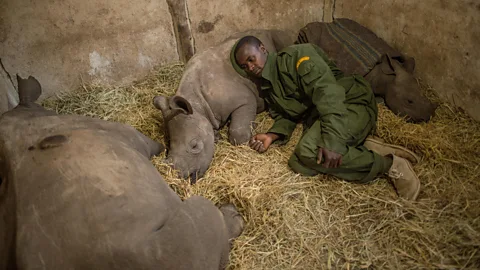 Ami Vitale/Alamy
Ami Vitale/AlamyKenya's rhinos, elephants, and zebras pull in millions of tourism dollars and supply jobs. Poachers threaten that – but an ambitious programme is combining the influence of local communities and innovative technology to keep them at bay.
Untold World
Untold World is a special series from BBC Future that covers technology’s global impact, far beyond Silicon Valley. Discover more stories about how technology is profoundly changing underreported communities the world over.
Josephine Ekiru is not nostalgic for the past. Growing up in northern Kenya in an impoverished home, she was surrounded by violence and loss. People regularly killed the wildlife she loved, and they killed each other. Tribal clashes stoked by resource scarcity and decades-long vendettas were the norm.
“The only thing I was seeing was death,” Ekiru recalls. “I grew up thinking, ‘One day, I’ll tell my people that conflict is not good, that it only takes us in a circle of poverty.’”
Luckily in 2011, when Ekiru was 24 years old, she discovered the Northern Rangelands Trust (NRT), an organisation composed of community conservancies in Kenya. Those animal conservancies reject violence in favour of peace, sustainability and responsible, shared management of land and wildlife.
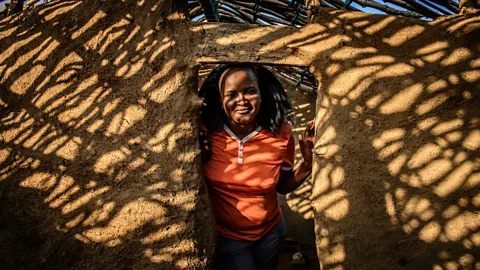 NRT
NRTAnd in the Kenyan conservancies, there’s good reason for protecting wildlife: it goes hand-in-hand with a drop in overall crime and tribal violence.
Conservancy rangers increased security by cutting down on theft, road banditry and cattle raiding, and when conflict did flare, NRT elders would intervene to de-escalate the situation before fighting could break out.
Established in 2004, the NRT currently supports 35 community conservancies spanning some 17,300-square miles in northern and coastal Kenya – making up an area larger than Denmark. Over 600,000 people there live alongside elephants, rhinos, lions, zebra, giraffe, buffalo and more.
Conservation is not something the local people do purely out of altruism, however. In a region that previously received close to zero tourists, NRT member conservancies now benefit from some 15,000 visitors per year.
Yet over the last decade, elephants and rhinos – the very things that the community conservancies depend on for tourist income – have come under siege in Kenya and beyond, thanks to surging prices for ivory and rhino horn in Asia.
While NRT conservancies have made significant headway with poachers, it’s not enough. So they’re adding a new strategy: using cutting-edge technologies to stop poaching and keep both people and animals safe – ultimately boosting everyone’s quality of life.
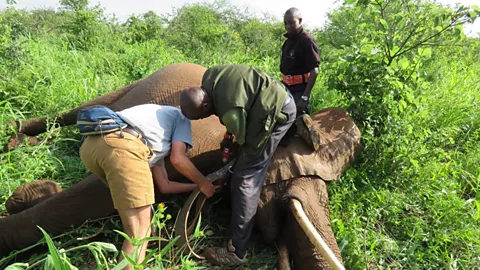 Ian Craig/NRT
Ian Craig/NRTIn nearby Samburu Conservancy, an NRT member, Ekiru could clearly see the tangible value of protecting a region’s wildlife and how it filters down do the human community. Samburu had tourist lodges and shared vehicles, and the land itself – verdant and teeming with life – was visibly healthier than the sparse, overgrazed savannahs where she lived. “This is another world,” she remembers thinking.
Ekiru contacted the NRT and then successfully campaigned at home for her community, Nakupurat-Gotu, to form a conservancy and join. Life has significantly changed for the better since then. “Without the NRT, Northern Kenya could be a war zone,” she says. “There would only be tears.”
The pay offs have been significant and are only growing. In 2016, NRT member conservancies brought in commercial income of over $600,000 (£461,000), mostly from tourism. “Wildlife is the catalyst that launched this, but there is also extraordinarily diverse habitat and deep, great culture,” says Ian Craig, who originally conceived of the NRT and now serves as its director of conservation. “With that, you’ve got a tourist product that drives economy and jobs, and brings government support because tourists need security.”
Around 10,000 people directly benefit from schools, renewable energy projects, water infrastructure and micro-finance initiatives, and more still enjoy other perks, including enhanced security, community phones in areas lacking cell service, new roads and a livestock purchasing programme that spares herders the long trip from field to market. Over 1,000 people are also employed by the NRT or work in related tourism jobs, including nearly 800 rangers, some of whom were former poachers.
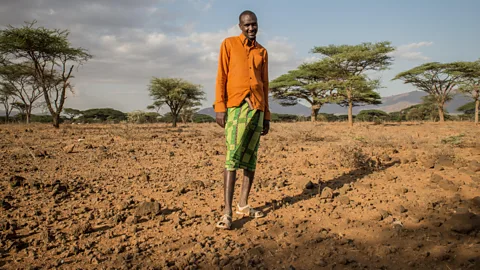 Alamy
AlamyEkiru, who used to receive frequent death threats from poachers who did not appreciate her meddling, converted many of them from killers to conservationists herself. Those men were once expendable tools of criminal traffickers, but now, Ekiru says, “You hear people saying, ‘These are our elephants.’” The community acts as the eyes and ears on the ground, preventing their own from being corrupted by the allure of fast but tainted money made through poaching, and informing rangers if suspicious strangers arrive in town.
“A poacher has to walk through a community to reach a rhino, but the community says, ‘No, no, we’re getting benefits from these rhinos – they’re for us,’” says Rob McNeil, chief of operations at the NRT. “They’re the outer onion-layer of support."
The strategy seems to be working. Lewa Wildlife Conservancy, where the NRT is headquartered, has not lost a rhino since 2013, even as Kenya as a whole lost 46 rhinos from 2014 to 2015. The population is doing so well, in fact, that in 2015, Lewa transferred 11 of its rare black rhino to Sera Conservancy, located a few hours north – making Sera the first contemporary community in East Africa to be directly responsible for protecting and caring for that critically endangered species.
This year, the Sera rhinos will bring in some $50,000 (£38,400) in revenue from tourists who drop by the conservancy for a rare chance to partake in rhino walking safaris. The profits are expected to increase by an order of magnitude in a few years. While the majority of the NRT conservancies’ funding currently comes from donors, the hope is that tourism will soon account for an increasing amount of core funding. “The latent potential for tourism in the NRT is massive – absolutely massive,” Craig says. “The area hasn’t even been touched.”
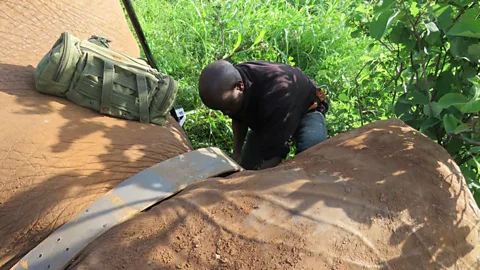 Iam Craig/NRT
Iam Craig/NRTWhile poaching has been significantly reduced compared to the past, the NRT security is not entirely bullet-proof. From 2015 to 2016, populations of endangered African wild dogs and endangered Grevy’s zebras decreased on over half of the conservancies’ land, and other species, including buffalo and plains zebra, were also found to be in decline in some places. Worst of all, elephants are still being poached: from 2014 to 2016, 51 of the 7,000 elephants that roam the conservancies were killed for their ivory. The poaching numbers are falling annually – in 2012 alone, 103 elephants were killed – but the situation still leaves room for improvement.
Keeping poaching at bay is not only important from a conservation perspective, but also a livelihoods one: it helps keep safe jobs and other benefits that the conservancies bring.
While the rangers in the field and communities on the ground are the most integral components for protecting wildlife, cutting edge technology can massively boost their abilities.
To take protection to the next level, conservation managers have partnered with Vulcan, a Seattle-based philanthropic company created by Microsoft co-founder Paul Allen, to create the ultimate programme for managing wild areas.
The Domain Awareness System (DAS), as it is called, is their software solution. It compiles into one neat map all the data about a given area – locations of elephants, rangers and vehicles, sites of past poaching incursions, gunshot detections, weather and more. The end result enables informed decision-making taken to an elite military level previously unimaginable to conservationists.
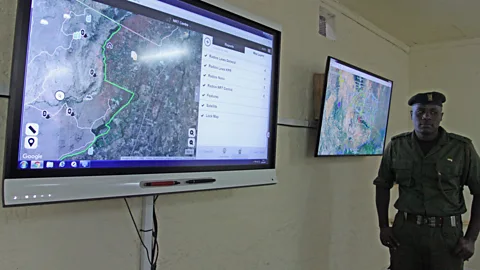 Rachel Nuwer
Rachel Nuwer“Unless we have one integrated visualisation and alerting platform, then we’ll have drones, sensors, cameras and all sorts of fancy things out collecting data, but it’ll all be a big mess,” says Ted Schmitt, Vulcan’s lead program manager for DAS. “Essentially, we’ve created a command and control solution for conservation.”
One stop software
DAS was, in some ways, dreamed up in the skies above Africa. As part of a massive scientific study, conservationists that Vulcan teamed up with flew their Cessnas around 18 countries, counting every live and dead elephant they saw. The data they collected made up the Great Elephant Census, the largest continent-wide survey ever undertaken. The results were telling: between 2007 and 2014, savannah elephants across Africa declined by 30%.
The disturbing findings prompted Allen to ask his team to find ways to help to reverse those trends. So Schmitt and his colleagues began posing the same question to all of the park managers with whom they were working: What did they most need to enable better protection of wildlife? “The thing we kept hearing was that even though they did not have enough data, they already felt overwhelmed by it,” he says. “There were all these little silos of data, but nothing to bring it into one picture to make use of it.”
So in 2015, Vulcan invited representatives from five conservation groups, including the NRT, to join them for a brainstorming session in Seattle. Based on their field partners’ input, Vulcan’s four DAS engineers got to work designing a system that worked not only in terms of data collection and presentation, but also in its ability to securely and reliably operate with the limited infrastructure and slow internet connections of most African protected areas.
 Ami Vitale/Alamy
Ami Vitale/AlamyDAS alpha testing began later that year at the NRT and Lewa’s joint security headquarters, and since then, the 1.0 product has been rolled out at eight additional sites, most recently in September. “We now have absolute minute-by-minute oversight of what’s happening,” Craig says.
On a recent afternoon in the Lewa-NRT Joint Operations Command Center, communications officer John Tanui, wearing a green uniform adorned with a silver rhino pin, paced between three large wall-mounted monitors, explaining the system to several foreign visitors – two of whom had travelled from South Africa to learn whether DAS might be an asset for protecting their own heavily poached rhinos. “DAS is coming up to be a big, powerful tool,” Tanui said. “It’ll save us a lot of time and energy.”
He pointed at the middle screen, a Smart Board that displayed a Google Earth landscape of orange and green overlaid with various icons – radios, rhinos, a plane and more. Those first symbols represented rangers in the field, whose radios include inbuilt GPS. Other multi-coloured icons scattered about the landscape revealed the location of 35 elephants, mostly matriarchs, tracked via GPS-enabled collars. Tanui pointed at one of them: “That’s Gambela. I can 100% assure you that she’s not alone.”
The collars that provide such precise tracking come courtesy of Save the Elephants, a Kenya-based non-profit. Based on scientific knowledge of animal behaviour and movement, experts there worked with the Vulcan engineers to develop elephant tracking software, which has been integrated into DAS and sends text alerts to rangers in the event of a possible problem. For example, if a collared elephant begins to streak – a sudden, panicked sprint of up to 60 miles in a single night – this may indicate that the herd has been attacked by poachers.
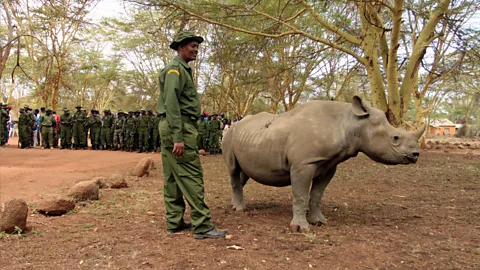 Rachel Nuwer
Rachel NuwerTanui tapped the monitor once more and brought up a list of geo-located reports. Three hours ago, for example, an NRT home reported a theft, while the day before, a ranger had radioed in the location of a rhino named Juniper and her calf. For easy sorting, such reports can be categorised with over 20 possible tags, from an animal track sighting to a carcass to rain.
Serious incidents involving weapons or crime, on the other hand, range in severity from amber to red and trigger automatic alerts to management, who immediately reach out to the appropriate police and government personnel for joint decision-making. “The police know there’s an eye looking at the bigger landscape – something the government doesn’t have the capacity to do – and they can easily coordinate their security systems with the support of this technology,” says Titus Letaapo, chief programs officer of the NRT. “It’s made their lives easier, too.”
All of these capabilities mean that, even standing in a room 130 miles away (210km) from the actual location of a poacher incursion, Tanui and others can follow the scene as it unfolds in real time, and issue appropriate instructions to their men. They can zoom in on the map to warn rangers that they are coming up on a large bush where poachers may be hiding, for example, or to tell them check a home located half a mile ahead.
After an incident concludes, it gets entered into the digital database and can be later recalled and rehashed. Over 10,000 events – from poaching incursions to human-wildlife conflicts – have already been put into the system at the handful of sites where DAS is operating, along with accompanying information such as weather, time of day and more. Once those data build up to even greater levels, applying machine learning techniques to them – an approach of “deep interest” to Allen, Schmitt says – may be used to predict when and where poaching is most likely to occur. “Everyone knows that poaching goes up during a full moon, but what other patterns are lurking in the data that aren’t known but can be found?” Schmitt says.
Schmitt has already received interest from 30 other protected area managers, including ones in South America and Asia. But even if DAS finds widespread application, it will not solve every challenge that the NRT conservancies and other parks and reserves face. It cannot fix protected areas that are plagued by corruption, mismanagement or apathy, and nor can it address larger strains caused by global warming and overpopulation. As Ekiru says, “We see the world changing: the population of people is adding up, but the land is not adding up along with it.”
But DAS will, at least, make the job of protecting wild places and the people and animals who live there easier – which will further reinforce communities’ commitments to conservation.
“I want to see a society with good smiles, with peace and with more women empowered,” Ekiru says. “I know it’s a process, but things are changing. I can see my grandchildren growing up and getting a good life.”
--
If you liked this story, sign up for the weekly bbc.com features newsletter, called “If You Only Read 6 Things This Week”. A handpicked selection of stories from BBC Future, Earth, Culture, Capital, and Travel, delivered to your inbox every Friday.
